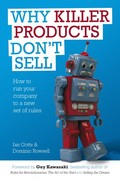Last week I met two entrepreneurs in the customer development phase of building start-up companies.
The first entrepreneur, Rajesh Setty founder of WittyParrot and many other startups led the "what we do" conversation with a demo and it was very clear after just one minute how their product creates value; the other took a while to explain what his company did and it took me even longer to "get it".
I asked both of them, how many times they expected to pitch their "big-idea" and "what-we-do" stories in the next year.
I asked both of them, how many times they expected to pitch their "big-idea" and "what-we-do" stories in the next year.
I qualified this by suggesting that they were not only pitching to prospects; they will be pitching to colleagues, prospective new hires, investors, business partners, friends and family, social networking contacts, web-site visitors and of course to strangers on a plane or at a cocktail party in response to the "so-what-do-you-guys-do?" question.
Rajesh suggested that he would probably pitch his story 2000 times in the next year, the other entrepreneur about 500 times. Let's pick a point in between, say 1000 and multiply this by 10, because both companies have about 10 employees today. Most are engineers, but all are going to be interacting with the above networks of partners, prospects and strangers.
Rajesh suggested that he would probably pitch his story 2000 times in the next year, the other entrepreneur about 500 times. Let's pick a point in between, say 1000 and multiply this by 10, because both companies have about 10 employees today. Most are engineers, but all are going to be interacting with the above networks of partners, prospects and strangers.
That's about 10,000 times for the company pitch in the next year....and of course in a start-up, the story is changing by the month as lessons are learned from product usage, use cases expand, and new capabilities are built into the product. In addition, if the company gains funding and grows, employee headcount may treble in the same period. How long will it take to enable new hires to get-on-message?
One entrepreneur rated the clarity of their value proposition at 1/10 and explained that he currently has a consultant working on helping him clarify it, Rajesh rated his message at 6/10 and a work in progress. The image below represents what is created when you are less than 7/10 for message clarity....pollution!

One entrepreneur rated the clarity of their value proposition at 1/10 and explained that he currently has a consultant working on helping him clarify it, Rajesh rated his message at 6/10 and a work in progress. The image below represents what is created when you are less than 7/10 for message clarity....pollution!

Poor messaging is like discarded waste; forgotten, of no value, to be buried forever from memory.
How then can a start-up, or an F500 company for that matter, address the problem of unclear messaging? If you have read this far I think you’ll agree that it’s important. The answer to the question is that it’s not easy.
How then can a start-up, or an F500 company for that matter, address the problem of unclear messaging? If you have read this far I think you’ll agree that it’s important. The answer to the question is that it’s not easy.
Often it’s hard for entrepreneurs to take the buyer’s view and to truly understand the problems the buyer is facing and how they could potentially use the products to create value… but this is the place to start. Hiring a consultant to help create clarity in messaging in the formative stages of company building is potentially a high-payoff investment. How important is message clarity to you?
I believe there is an opportunity to create a software as a service product to create and maintain messaging that resonates with buyers, that everyone from entrepreneurs to marketing managers in F500 companies can use and I’m in the process of building it and we are interested in talking to early adopters in our customer discovery phase of development.
We helped an Israeli technology company re-launch their Infrastructure as a Service product at a critical time in the evolution of public and private cloud solutions and it was transformational for the company. They weren't looking for a consultant to help with messaging, but recognized they were about 4/10 for clarity in their value prop at the time. We began by creating buyer-persona’s around best guess use cases.
We helped to create a messaging architecture that identified the relevant capabilities and grouped them under logical positioning pillars.

We then generated sales ready messaging for the sales team to use when engaging prospects over the phone and in person and trained the sales team to use it in consultative conversations.
The marketing team used the messaging to transform their Website message from product-centric gobbledygook to buyer-relevant copy. Marketing managers in each country began to use the messaging in creating blog articles and they quickly began to generate new visitors that converted into inbound leads and new-name customers in the first 6 months after the messaging workshop.
Since this engagement, we have added visual storytelling to our methodology, to capture the value proposition in a meaningful visual confection where both salespeople and buyers can quickly "get", remember and communicate your “big idea” and value proposition.

I believe there is an opportunity to create a software as a service product to create and maintain messaging that resonates with buyers, that everyone from entrepreneurs to marketing managers in F500 companies can use and I’m in the process of building it and we are interested in talking to early adopters in our customer discovery phase of development.
We helped an Israeli technology company re-launch their Infrastructure as a Service product at a critical time in the evolution of public and private cloud solutions and it was transformational for the company. They weren't looking for a consultant to help with messaging, but recognized they were about 4/10 for clarity in their value prop at the time. We began by creating buyer-persona’s around best guess use cases.
We helped to create a messaging architecture that identified the relevant capabilities and grouped them under logical positioning pillars.

We then generated sales ready messaging for the sales team to use when engaging prospects over the phone and in person and trained the sales team to use it in consultative conversations.
The marketing team used the messaging to transform their Website message from product-centric gobbledygook to buyer-relevant copy. Marketing managers in each country began to use the messaging in creating blog articles and they quickly began to generate new visitors that converted into inbound leads and new-name customers in the first 6 months after the messaging workshop.
Since this engagement, we have added visual storytelling to our methodology, to capture the value proposition in a meaningful visual confection where both salespeople and buyers can quickly "get", remember and communicate your “big idea” and value proposition.
Take-Aways
- It's never too early to get clear about your value proposition.
- If you can't nail your value proposition for the users you are trying to attract and sell to, how can you expect to get them excited about using your product or service?
- The sales cycle starts in marketing with content creation and if the content you create doesn't resonate with your target buyers, they won't come.
- If you cannot answer the next three questions with absolute simplicity and clarity so your ideal prospect can understand it, you have work to do.
- So-what-is-it-you-guys-do-then?
- What is a metaphor for an existing product idea, service or capability could you use to help a buyer who does not know your product or company to instantly understand how they could use your product?
- Why should I buy from you?





